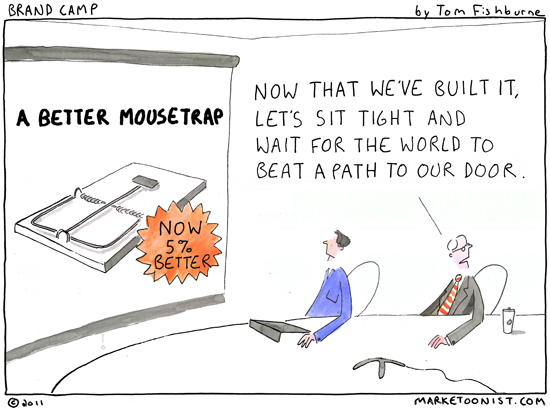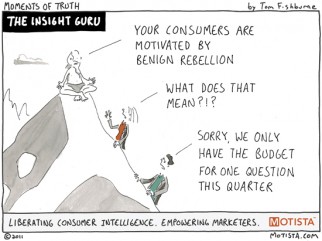“Build a better mousetrap, and the world will beat a path to your door.” This is one of the most quoted innovation credos. Yet it’s also untrue.
Innovation experts call this the “Better Mousetrap Fallacy”, because the credo focuses solely on the technology and not on the consumer. Consumers really don’t care about a better mousetrap. They care about fewer mice.
Or as HBS marketing professor Ted Levitt put it, “People don’t want to buy a quarter-inch drill. They want a quarter-inch hole.”
My friend Todd Sattersten addresses this issue in his new book called “Every Book Is a Startup“. It’s an inspiring book, not only on the future of book publishing, but really any type of innovation. Todd writes about the often overlooked role of “Felt Need” in innovation, as originated by publisher Ray Bard. It’s not enough for the innovation to represent a technological advance. It has to to tap a “Felt Need” by the consumer.
 Todd and Ray characterize “Felt Need” in four different categories based on the depth of “Felt Need” and the breadth of the audience: the Pond, the Bayou, the Well, and the Ocean. Many businesses launch new innovations for the Bayou, a mile wide and only 18 inches deep. Those innovations have low “Felt Need”. It doesn’t matter how technologically advanced they are. The real opportunities lie in Wells and Oceans.
Todd and Ray characterize “Felt Need” in four different categories based on the depth of “Felt Need” and the breadth of the audience: the Pond, the Bayou, the Well, and the Ocean. Many businesses launch new innovations for the Bayou, a mile wide and only 18 inches deep. Those innovations have low “Felt Need”. It doesn’t matter how technologically advanced they are. The real opportunities lie in Wells and Oceans.
 Dyson is a master of “Felt Need”. On the surface, it may appear that Dyson excels at building better mousetraps (with innovation breakthroughs in vacuum cleaners, hand dryers, and, most recently, fans). Yet, it wasn’t the technological advances alone that made their success possible. Dyson tapped a “Felt Need”. I remember when the Dyson vacuum first came out, my wife started a Dyson fund, putting $20 a week in an envelope until she had enough to buy one. She acutely felt the need for a Dyson based on her dissatisfaction with previous options.
Dyson is a master of “Felt Need”. On the surface, it may appear that Dyson excels at building better mousetraps (with innovation breakthroughs in vacuum cleaners, hand dryers, and, most recently, fans). Yet, it wasn’t the technological advances alone that made their success possible. Dyson tapped a “Felt Need”. I remember when the Dyson vacuum first came out, my wife started a Dyson fund, putting $20 a week in an envelope until she had enough to buy one. She acutely felt the need for a Dyson based on her dissatisfaction with previous options.
Delivering against “Felt Need”, not merely building a better mousetrap, is what drives the world to beat a path to your door.



Mars Dorian says
That’s interesting, Tom , and I can see how that applies to the commodity business.
But what about art ? Where’s the felt need there ?
Logically speaking, there’s no need for that – yet people tend to buy amazing work feverishly.
I somehow still believe that most people don’t know what they want, and that one has to create the work that he or she loves and not worry too much about market demand in the real world.
Sounds ridiculous, but in the end, I can only create for myself, and see if the public feels the same about the work as I do.
Nannette Stangle-Castor says
Tom – you have captured a key challenge that we often see in helping organizations commercialize their technology. This “build it and they will come” mentality is pervasive. Technology without appreciation for market needs will not usually be successful.
James Wroe says
A very apt point for me particularly as a few days back I was listening to an executive fielding a question on whether his company’s efforts on product and service development would be reflected in improved customer satisfaction.
Part of the response was along the lines of needing to explain the benefits of those developments to customers, something which could indicate a need isn’t being fulfilled, given the customer doesn’t perceive an improvement has been delivered.
Michael Fruhling says
Hi Tom: Great post. Maybe my comment shows that I am not part of Dyson’s target audience, but $180 for a cool looking fan? I don’t get it. What is the Felt Need that drives a consumer to shell out so much money for one of these? I understand the needs driver for a Dyson vacuum. Is there so much inherent dissatisfaction with conventional fans?
Best regards,
Michael Fruhling
@TheGirlPie says
Thank you Tom, for naming the originator of the famous drill/hole quote — and for the Todd + Ray chart — each deserves his due, and all clarify the importance of “Felt Need,” which I can see behind any purchase. (Looking into Todd’s book now.)
@Mars — the “Felt Need” motivating art purchases is varied but the primary one is universal and timeless: man feels the need to connect to an expression of emotion, beauty, singular or shared perspective. (Additional reasons are the “need” for an investment, an ego statement, or to cover a blank spot on a wall~!)
Thanks for your useful brief on a common misconception, Tom — your sharp pane says it all~!
Mark Whitehead says
You have to take the felt need in context with the audience size. some people need to be cool whilst being cool, while some people need to buy and display art.
Buying is not a logical desicion, its an emotional one.
It comes down to discovering a felt need, solving it, identifying the target market that has the need and communicating that you can solve their problem.
I guess that’s a bit simplistic, but we are analysing a cartoon afterall 🙂
Hope that helps,
Mark.
Sue says
Tom – thanks for summing this up. Those of us marketing in the “new media” frequently get lost in the shiny object – coolest, newest, most innovative. In the end – we need to THINK LIKE OUR CONSUMERS.
They aren’t wandering around saying “Who has the latest technology displaying the thing I desperately need?” but instead “Who has that thing I desperately need?”
Ted Wachholz says
I would love to see Ted Levitt (“people don’t want to buy a quarter-inch drill, they want a quarter-inch hole”) and Henry Ford (“if I had asked people what they wanted, they would have said faster horses”) come together in the same room and debate the merits of their different (yet related) perspectives. 😀
euonymous says
You can tell the pioneers, they’re the ones with the arrows in their backs, as a wise man once said. The first and/or better mousetrap doesn’t win; the best marketed mousetrap wins. In theory, betamax was better. In reality, I was told by engineers, Adobe’s technology wasn’t quite as good as (who knows? as a company they died), but Adobe knew how to market. And Thomas Edison didn’t invent the lightbulb, either, although that’s the name you think of. It’s all marketing. Heh heh.
tomfishburne says
Hi all,
Great comments this week, many thanks!
This week’s cartoon goes to Ted. I love the tension embodied by those two classic marketing quotes: Ted Levitt (“people don’t want to buy a quarter-inch drill, they want a quarter-inch hole”) and Henry Ford (“if I had asked people what they wanted, they would have said faster horses”).
At first, they seem in direct conflict, which is funny because I agree with them both. What resolves it for me is that “faster horses” are a type of “quarter-inch drill”. They are both potential solutions to a Felt Need. But a good understanding of the Felt Need is what is most important.
It reminds me of a Clayton Christensen article called “What Customers Want from Your Products”, which uses Levitt’s quote as a jumping off point: http://hbswk.hbs.edu/item/5170.html . In the article, Clayton gives an example of a company that makes milkshakes. They ask customers what they want from a milkshake (more chocolatey, chunkier, cheaper, etc.) but get stock answers that aren’t that insightful. Then, they discover that 40% of the milkshakes were purchased in the early morning. Customers were buying them for the commute. Once they understood that insight, they created a “Better Milkshake” centered around a true “Felt Need” (optimized for consumption in a car in the morning).
Customers may not be able to articulate the ideal product. But with probing, they can shed light on the Felt Need. In Clayton’s words, “The job, not the customer, is the fundamental unit of analysis”. “Faster horses” and “quarter-inch drills” are potential solutions to the job.
Michael, you may be right. I’m not in the Dyson fan market either (at least at $180) but I can sense the Felt Need in what’s wrong with current fans (blades, noise, irregular flow). It will be interesting to see who values that Felt Need at $180. I’m banking a bit on their success with the vacuum (at launch, $400 seemed ludicrous for a vacuum). I suspect the market is there, but I wonder if it’s a Well or an Ocean.
All the best!
-Tom